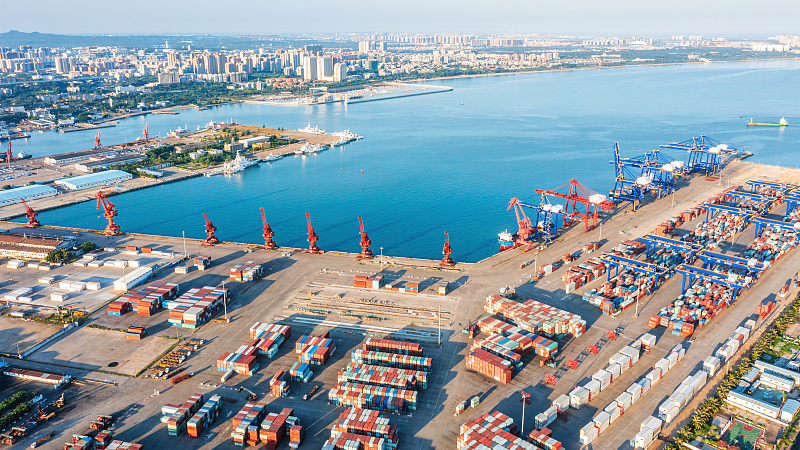
Xiuying Port in China's Hainan Province. /CFP
Xiuying Port in China's Hainan Province. /CFP
Editor's note: Liu Chunsheng is an associate professor at the Beijing-based Central University of Finance and Economics. The article reflects the author's opinion, and not necessarily the views of CGTN.
Over the last three years, the world suffered from the COVID-19 pandemic. According to the data released by the International Monetary Fund (IMF), in 2020, the world economic growth was -3 percent, while that of advanced economy was -4.4 percent and that of emerging market and developing economies was -1.9 percent.
China was the only major economy that recovered from pandemic shock and kept positive growth rate in 2020. A 2.3 percent year-on-year economic growth shone in the global recession during the toughest pandemic time. At the same time, China made every effort to prevent millions of lives from been threatened by COVID-19 and its consequent overwhelming strain on medical resources.
In 2021, new virus mutations raised concerns, even as growing vaccine coverage lifted sentiment. Global economy enjoyed booms after a wounded 2020 but recoveries diverged across countries and sectors, reflecting variation in pandemic-induced disruptions and the extent of policy support.
China introduced many policies to support its economic pick-up and the result turned out to be marvelous. China's economy rose 8.1 percent in 2021 which showed strong resilience, hit a periodical high and became one of the most important driving forces in the world.
Also in 2021, China took up 18.5 percent of world economy. Balance between economy and epidemic prevention and control throughout China proved to be successful and gained admiration around the world.
In 2022, China's economy experienced tough times. The COVID-19 pandemic led to lockdown in many cities, resulting in production and operation interruption in many industries.
According to the National Bureau of Statistics, China's economy went up 3 percent and its GDP hit a historical high of 120 trillion yuan (about $17.7 trillion), better than the market expectation from both domestic and overseas investment institutions and international organizations.
IMF predicted the GDP growth of the United States and Japan would not exceed 2 percent and Germany's GDP would grow by 1.9 percent in 2022. Compared to these, China's economic growth rate of 3 percent is relatively fast.
At the annual average exchange rate, China's GDP per capita reached $12741, and remained above $12000 for two consecutive years. The continuous improvement of the economic aggregate and per capita level means that China's comprehensive national strength, international influence and people's living standards are further developed.

Posters promoting the benefits of COVID-19 vaccination for the elderly are seen at the entrance of a supermarket in Daxing district, Beijing, January 8, 2023. /CFP
Posters promoting the benefits of COVID-19 vaccination for the elderly are seen at the entrance of a supermarket in Daxing district, Beijing, January 8, 2023. /CFP
From 2020-2022, the average annual growth of China's economy was 4.5 percent, significantly higher than the world average. China's economic situation attracted attentions from all over the world, mainly because the world economy is predicted to slow down sharply in 2023 and in the last decade, China was the largest driving force for the global economy.
According to the data of World Bank, from 2013 to 2021, China contributed up to 38.6 percent on average to world economic growth, more than the G7 countries combined.
While keeping economy moving forward, China's inflation rate remained low and stable. When the Western world suffered from higher commodities prices and lower living standards, Chinese people were not worried about the boiling inflation and its vicious consequences.
China's import and export continued to climb new peaks and made great contributions to global trade in the past three years despite turbulence and uncertainty arising from the COVID-19 pandemic, China-U.S. trade frictions, Russia-Ukraine crisis, de-globalization and trade protectionism.
China has maintained the status of the world's largest trading country in goods for six consecutive years. In 2021, the scale of China's import and export reached $6.05 trillion and hit a record high of $6 trillion after eight years of reaching $4 trillion for the first time in 2013. China's foreign trade played a key role in maintaining the stability of the global industrial chain and supply chain and international anti-epidemic cooperation.
With its good economic development prospects and continuously optimized business environment, China continued to be a popular destination for global investment and businesses. In the first 11 months of 2022, China's actual use of foreign capital was 1156.1 billion yuan, up 9.9 percent year-on-year.
Looking ahead, China's economic recovery will release more potentials in 2023 and will inject more vitality into the world economy. In fact, consumptions boom in catering, tourism and entertainment sectors during the Spring Festival holidays has indicated that China's economy will not fail the expectations from all over the world in 2023.
(If you want to contribute and have specific expertise, please contact us at opinions@cgtn.com. Follow @thouse_opinions on Twitter to discover the latest commentaries in the CGTN Opinion Section.)